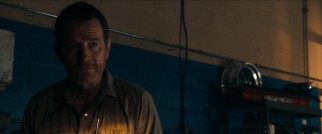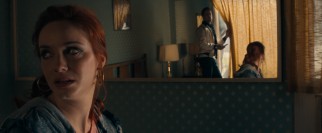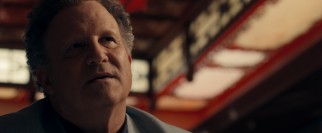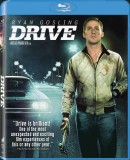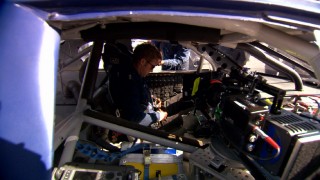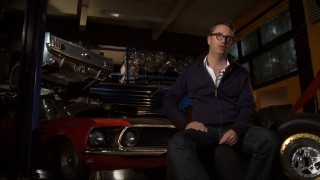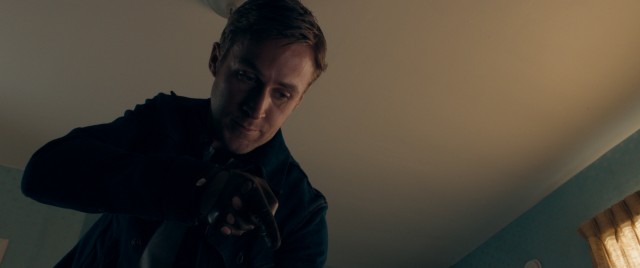Drive Blu-ray Review
 |
Drive
Theatrical Release: September 16, 2011 / Running Time: 100 Minutes / Rating: R / Songs List Director: Nicholas Winding Refn / Writers: James Sallis (book), Hossein Amini (screenplay) Cast: Ryan Gosling (Driver), Carey Mulligan (Irene), Bryan Cranston (Shannon), Albert Brooks (Bernie Rose), Oscar Isaac (Standard Gabriel), Christina Hendricks (Blanche), Ron Perlman (Nino), Kaden Leos (Benicio), Jeff Wolfe (Tan Suit), James Bibleri (Cook), Russ Tamblyn (Doc) |
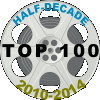 | Drive ranks 27th in our list of the Top 100 Movies of the Half-Decade (2010-2014). |
Buy Drive from Amazon.com: Blu-ray + UltraViolet Digital Copy DVD Instant Video
Ryan Gosling has been the most buzzed-about actor of his generation for some time now, but the buzzing hit fever pitch last year. Over the course of three months, three of 2011's best-reviewed movies were released, each with Gosling in a starring role. That boom of activity not only reasserted the 31-year-old Canadian as one of Hollywood's most in-demand young talents, it also displayed his range. In between those two high-profile films, there was Drive, a most unusual beast. This widely-released crime action movie with an arthouse aesthetic is the big American breakthrough of director Nicholas Winding Refn. That isn't a name you'd easily forget; it's more likely one you didn't know from his first fifteen years in filmmaking. Refn primarily worked in his native Denmark, where he wrote and directed the Pusher crime trilogy. Not ringing any bells? Perhaps you've heard of his other credits: the 2003 psychological thriller Fear X, the English language debut that bankrupted his production company; the Tom Hardy prison film Bronson; and the Middle Ages adventure Valhalla Rising. Such films may be obscure to the general public, but they might well be worth checking out now because Drive establishes Refn as a bold, original filmmaker to watch.
The first film Refn directed but did not write, Drive is adapted from the 2005 novel of the same name by under-the-radar American crime author James Sallis. It tells the story of an unnamed Hollywood stunt driver (Gosling), who uses his expertise behind the steering wheel to earn some extra cash as a getaway driver comfortable with more than a little danger. The opening narration spells out the extent of our protagonist's detached criminality. His non-negotiable service gives five minutes to carry out break-ins, robberies, or other unknown mayhem. As long as you get back to the car before those five minutes are up, the driver promises to get you safely and soundly out of heat.
An arresting, mostly silent ten-minute prologue shows us the driver in action, as he picks up two men in ski masks and deftly avoids police notice, ducking under bridges and killing his headlights as needed. It's a pulse-pounding escape that casts you as an active participant. While you may feel guilty eluding the law, you don't feel that guilty. The quiet driver has won your sympathy, as a cool unarmed bystander not directly involved in wrongdoing. Even when he's suppressing his signature dimpled grin in favor of collected silence, Gosling exudes likability and we feel like we're in safe, decent hands sitting in his passenger seat.
The driver's tender side ever so slightly peeks out in his interactions with Irene (Carrie Mulligan), a neighbor in his earthy Los Angeles apartment building. While her husband is doing time in jail, Irene is caring for his son Benicio (Kaden Leos). The driver helps them with car troubles with rides and at the body shop that is his third workplace. A minimum of dialogue is exchanged between the three, but that is no obstacle to us understanding how quickly the mother and child come to mean something special to the driver.
That meaning motivates the conflict, when Irene's husband Standard (Oscar Isaac) is released and is roughed up to pay back thousands in prison protection money to some gangsters. With Standard's wife and son in mind, the driver volunteers to help Standard perform the one final heist he is being pressured into, a pawn store robbery. When that goes awry, the driver finds himself in possession of the loot and in the crosshairs of two serious gangsters (Albert Brooks and Ron Perlman).
Straightforward plot summary does not do justice to the film, which soars less on dialogue and story than on atmosphere and style. The screenplay by Iranian scribe Hossein Amini The director creates and sustains supremely compelling scenery, utilizing slow motion, aerial and overhead shots of Los Angeles nights, and a soundtrack of '80s-style electronic ballads. That probably doesn't sound spectacular on paper, but on film it sizzles, keeping you riveted with slow-boiled tension. This is not like other movies. Despite the musical selections (all of which, in fact, are just from the last few years) and the hot pink titles, this is no homage to '80s cinema. Nor, though it might be tempting, can you fairly classify this alongside Christopher Nolan and the Michael Mann works that inspire him. The themes and texture may be comparable, but the execution is distinct and appealing in its own wonderfully unique way.
It's a curious and impressive feat that Refn is able to take these wholly disparate elements -- an unironically cheesy musical sensibility, a reticent toothpick-chewing loner in an unfashionable silver jacket and driving gloves, archetypal contemporary criminal types, a supporting cast of cable drama actors (including "Breaking Bad"'s Bryan Cranston and "Mad Men"'s Christina Hendricks), high-energy action, and unflinching violence -- and turn them into one of the coolest and most confident movies of this century. Some have drawn parallels to the 1978 Walter Hill movie The Driver, which itself may be cut from the same cloth as Jean-Pierre Melville's Le Samouraο and the litany of films it has inspired (such as John Woo's The Killer). But these are not things ingrained into the minds of modern moviegoers or even many cineastes. To them, Drive is simply different and exciting in ways that cinema rarely is.
I have just one reservation about the film and that is in regard to its violent content. To even suggest tempering it down (as the MPAA presumably might have to avoid an NC-17 rating) would be neutering one of the boldest and most original voices in a while. But even though it's not especially gratuitous (in fact choosing to leave some horrors unseen but all too clearly heard), the cringeworthy graphic material will unfortunately turn off those who might otherwise be hooked. It is at odds with the chaste depiction of love, but I suppose the point is to contrast the different worlds and see if a benign laconic can survive being thrust among ruthless criminals.
Though it received some of the most universal and electronically vocal praise of any 2011 movie, Drive stalled at the box office, grossing just $35 million in nearly 3,000 theaters. The movie has also taken a few hits in the last week, with Quentin Tarantino writing it off as a condescending "nice try" in his now annual surprisingly down-to-earth year-end review list. Then, yesterday morning, Albert Brooks, who had been receiving critic awards and nominations left and right for his against-type turn as an eyebrowless heavy and had been predicted as the second surest thing behind Christopher Plummer in the Supporting Actor category, was snubbed by the Academy, who only recognized the movie for its sound editing.
The perceived injustice was widely lamented on the Internet, which has designated it its most prized 2011 movie. But perhaps the snub is more of a blow to the Oscars' credibility, confirming the fuddy-duddy predictability (even and especially in unexpected selections, like The Blind Side and Extremely Loud and Incredibly Close) one expects of a body whose average age continues to soar above that of the typical paying moviegoer. Anyway, Drive is too cool for the Oscars.
Less perfectly timed than it might have been with some Oscar attention, Drive comes to DVD and Blu-ray next Tuesday from FilmDistrict video distributor Sony Pictures Home Entertainment.
VIDEO and AUDIO Excellent transfers of new studio films are the norm today, especially on Blu-ray, but excellence is easier to appreciate on a movie as skillfully composed as this one. The stunning 2.40:1 picture and extraordinary 5.1 DTS-HD master audio are nothing short of flawless, heightening the already remarkable experience. The bold soundtrack choices, Oscar-nominated sound design, and inspired, deliberate frames are especially easy to admire here.
BONUS FEATURES, MENUS, PACKAGING and DESIGN Drive is joined by four hi-def making-of featurettes that gather remarks from screenwriter Hossein Amini, leading cast members, and select crew, but, oddly, not Refn or Gosling. "I Drive" (5:26) considers the story, lead character, and director. "Under the Hood" (11:50) discusses the project's development, supporting cast, collaboration, and characterization, the recurring theme being how characters changed from the way they were conceived. "Driver and Irene" (6:14) explores the understated romance that, uh, drives the film, primarily from Mulligan and Irene's points of view. "Cut to the Chase" (4:35) looks at staging and shooting the film's driving sequences.
Filling a void, "Drive Without a Driver: Entretien Avec Nicolas Winding Refn" (25:41) presents a leased one-sided HD interview with the director on Drive. Drive's trailer is unfortunately not included on the disc, although you can stream it, along with countless other Sony previews, through BD-Live, patience and Internet connection permitting. Without a connection, you can still enjoy a Previews reel that promotes Blu-ray, The Rum Diary, London Boulevard, Meeting Evil, In the Land of Blood & Honey, and Take Shelter. Finally, if streaming to computers and portable devices is your idea of fun, you'll be pleased to know that Sony includes a unique code for redeeming an UltraViolet digital copy of Drive with this Blu-ray. The appealing menu plays refracted clips from the film accompanied by upbeat score. The scorpion loading icon is a nice touch. Being a Sony disc, this supports bookmarks and resumes playback. Being a Sony disc, the side-snapped case displays art on both sides. Two inserts give you your UltraViolet and Sony Movie Rewards codes while using their back sides to promote other Sony products.
CLOSING THOUGHTS Bold, brilliant, and endlessly cinematic, Drive is one of 2011's best films and announces an exciting original talent in director Nicholas Winding Refn. So long as you can handle what the MPAA refers to as "strong brutal bloody violence", I think you will greatly enjoy this stylish, artistic, operatic action film. Sony's Blu-ray delivers a dynamic feature presentation and a decent collection of extras highlighted by Refn's revealing solo interview. It's a highly recommended disc. Support this site and great cinema when you buy Drive now from Amazon.com:
|
Related Reviews:
Buy Drive: Original Motion Picture Soundtrack
DVDizzy.com | DVD and Blu-ray Reviews | New and Upcoming DVD & Blu-ray Schedule | Upcoming Cover Art | Search This Site
DVDizzy.com Top Stories:
Ryan Gosling: The Ides of March Crazy, Stupid, Love. Blue Valentine Remember the Titans
Carey Mulligan: An Education | Bryan Cranston: Breaking Bad: The Complete Second Season Contagion
Albert Brooks: Taxi Driver Broadcast News Finding Nemo | Ron Perlman: Season of the Witch Hellboy II: The Golden Army
Crime Films: Blood Simple. Faster No Country for Old Men Jackie Brown City of Men Middle Men
Fall 2011 Films: Moneyball Paranormal Activity 3 | Vroom Vroom: Drive Angry Eat My Dust Cars
Drive Songs List (in order of first use):
The Chromatics - "Tick of the Clock"
Kavinsky - "Nightcall"
College (featuring Electric Youth) - "A Real Hero"
Desire - "Under Your Spell"
"Back in Toon"
Riz Ortolani (featuring Katrina Ranieri) - "Oh My Love"
Amazon.com: CD MP3 Download
Reviewed January 25, 2012.
Text copyright 2012 DVDizzy.com. Images copyright 2011 FilmDistrict, Bold Films, OddLot Entertainment, and 2012 Sony Pictures Home Entertainment.
Unauthorized reproduction prohibited.


